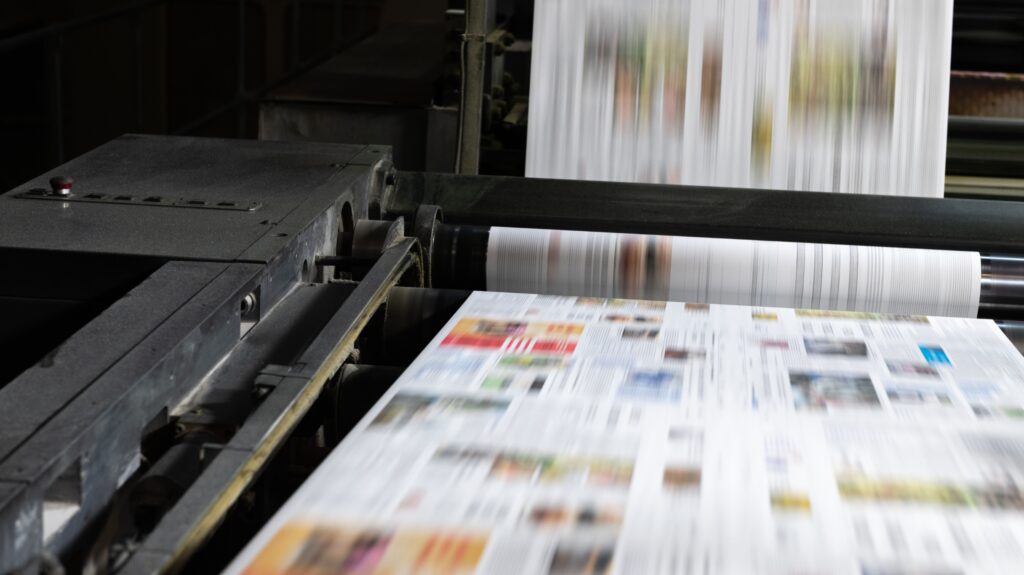Different Types of Ink In The Printing Industry
This post was last updated on January 16th, 2024
In the dynamic realm of the printing industry, where precision and vibrancy are paramount, the choice of ink plays a pivotal role in determining the final output. Printing technologies have evolved over the years, as have the types of ink used, and there is a wide and varied choice when looking at the available inks you can purchase.

In this post, we will journey through the diverse palette of inks that grace the printing presses, each with unique characteristics and applications.
Contents
ToggleLithographic Ink: Timeless Elegance
Lithography, a printing method that relies on the immiscibility of oil and water, is a classic technique that has stood the test of time. Lithographic ink, typically oil-based, is known for its versatility and ability to produce sharp, high-quality prints. This type of ink is ideal for various applications, from fine art prints to mass-produced materials like posters and packaging. Its slow-drying nature allows for a consistent finish, making lithographic ink a favourite in high-end printing.
Flexographic Ink: The Workhorse Of Packaging
Flexographic printing is the go-to option for the packaging industry, where speed and efficiency are key. Flexographic ink, based on water or solvent, is designed to adhere well to various substrates, including plastics, foils, and paper. Its quick-drying nature and ability to print on multiple surfaces make it indispensable for producing labels, flexible packaging, and corrugated cardboard. The versatility of flexographic ink ensures that it remains a staple in the fast-paced world of packaging.
Gravure Ink: Unrivalled Detail In Reproduction
Regarding reproducing intricate details and achieving unparalleled image quality, gravure printing takes centre stage. Gravure ink, typically solvent-based, is renowned for transferring fine details onto various materials. It is the preferred option for high-quality printing applications, such as magazines, catalogues, and high-end packaging. While gravure printing may not be as widely used as other methods, its ability to deliver unmatched detail places it in a league of its own.
Digital Ink: Revolutionising The Game
In the digital age, where speed and customisation are crucial, digital ink has emerged as a game-changer. Unlike traditional printing methods that rely on plates and rollers, digital printing uses electronic files to transfer ink onto the substrate directly. Digital ink comes in various formulations, including water-based, solvent-based, and UV-curable options. Its versatility makes it suitable for multiple applications, from short-run projects to personalised printing, such as variable data printing and on-demand packaging.
UV-Curable Ink: Setting New Standards
UV-curable ink has gained popularity for its ability to cure quickly when exposed to ultraviolet (UV) light. This fast-curing process enhances production speed and minimises the environmental impact by reducing the release of volatile organic compounds (VOCs). UV-curable ink is common in large-format printing, signage, and label production. Its durability and resistance to fading make it an excellent choice for outdoor applications, where exposure to the elements is a constant challenge.
Eco-Solvent Ink: Merging Quality With Environmental Responsibility
As environmental consciousness grows, so does the demand for eco-friendly printing solutions. Eco-solvent ink, derived from non-aggressive solvents, balances print quality and environmental responsibility. This type of ink is commonly used in wide-format printing, producing vibrant and durable prints on materials such as vinyl and canvas. The reduced emission of harmful substances makes eco-solvent ink appealing for businesses looking to minimise their ecological footprint.
Thermal Ink: Revolutionising Product Packaging
Thermal ink used in a thermal ink printer has gained prominence for its suitability in thermal transfer printing, commonly used in label and barcode printing. This ink type relies on heat to transfer the image onto the substrate, making it an efficient choice for high-speed and high-resolution printing. Thermal ink offers durability and resistance to environmental factors, making it ideal for applications where longevity is crucial.
Dye Sublimation Ink: Bringing Prints To Life On Fabrics
Dye sublimation ink is specially formulated for fabric printing, making it a go-to option for the textile and apparel industries. In this process, the ink is converted into a gas when heated, allowing it to penetrate the fabric and create vibrant, long-lasting prints. It is common to use dye sublimation for producing custom apparel, soft signage, and promotional items. Its ability to infuse prints directly into the fabric ensures a soft feel and excellent washability, making it a preferred choice for textile applications.
In the ever-evolving landscape of the printing industry, the choice of ink is a critical factor that can significantly impact the final product. From the timeless elegance of lithographic ink to the rapid advancements in digital and UV-curable inks, each type brings its own set of capabilities and advantages to the table. As the industry continues to push boundaries and embrace sustainability, the quest for innovative ink formulations that deliver exceptional quality while minimising environmental impact remains a driving force in shaping the future of printing. Choose your ink wisely and it can help your business become a resounding success.
Recommended For You
Best Online Art Galleries to Buy Original Paintings
Most Inside
Most Inside offers high-quality recommendations and valuable updates to enhance all aspects of your life, providing premium guidance and enriching experiences.




